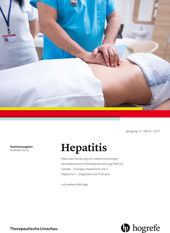Nichtalkoholische Fettlebererkrankung (NAFLD)
Abstract
Zusammenfassung. Die nichtalkoholische Fettlebererkrankung ist in den westlichen Industriestaaten die häufigste Ursache einer Hepatopathie und die Tendenz ist steigend. Grund dafür ist u. a. die rapide Zunahme der Prävalenz von Adipositas und Diabetes mellitus Typ 2. NAFLD und Metabolisches Syndrom bedingen sich hierbei gegenseitig. Als weiterer Pathomechanismus wird derzeit auch ein Zusammenhang zum Mikrobiom diskutiert. Ausserdem wurden verschiedene Genloci identifiziert die möglicherweise eine Prädisposition für die Entwicklung einer NAFLD darstellen. In der Diagnostik spielt die Sonographie eine wichtige Rolle, hinzukommen nicht invasive Verfahren zur Abschätzung von Fettgehalt, Entzündung und Fibrose wie z. B. der FibroScan. Um letztendlich eine Entzündung, Fibrose oder Zirrhose zu beweisen und exakt zu klassifizieren, bleibt der Goldstandard jedoch nach wie vor die Leberbiopsie. Die im Anfangsstadium vorliegende reine Steatosis hepatis kann sich im Verlauf zur Steatohepatitis und schlussendlich zur Zirrhose entwickeln. Diese Zirrhose sowie daraus entstandene hepatozelluläre Karzinome spielen als Indikation für eine Lebertransplantation eine immer grössere Rolle. Eine kausale, medikamentöse Behandlung der NAFLD steht aktuell noch nicht zur Verfügung. Die bestmögliche Therapie besteht derzeit in einer Lifestyle-Änderung und vermehrter körperlicher Aktivität. Eine nicht unwesentliche Rolle spielen auch Medikamente zur Behandlung des metabolischen Syndroms, wie Statine und Antidiabetika. Der mögliche positive Einfluss von Vitamin-E, Ursodesoxycholsäure und Koffein ist nach wie vor umstritten.
Abstract. Non-alcoholic fatty liver disease (NAFLD) is the most common cause for liver disease in western countries and incidence is rising. The reason for that is a rapid increase in prevalence of obesity and type 2 diabetes. The interaction between metabolic syndrome and NAFLD seems to be bidirectional. Moreover, a possible effect of gut microbiota is discussed as well as several genetic modifiers. For non-invasive assessment ultrasound plays an important role. Transient elastography is a good tool for evaluating the state of fibrosis. But nevertheless liver biopsy is the only method that reliably differentiates between NAFL and NASH. NAFLD includes three different, correlating manifestations: steatosis alone (NAFL), steatosis with ballooning and inflammation (NASH) and fibrosis. The last two deserve particular attention, because the risk for cirrhosis and the corresponding complications is high. HCC in the context of NASH is going to be the leading indication for liver transplantation in the following years. An effective, causal pharmacotherapy is currently not available. Lifestyle correction with weight loss and physical activity is mandatory in all patients and can show obvious improvement. Other components of the metabolic syndrome should be carefully managed according to local guidelines.



